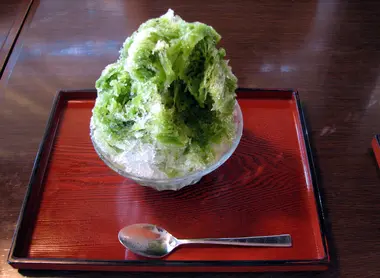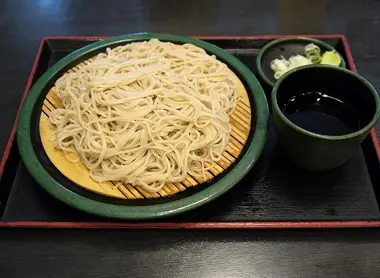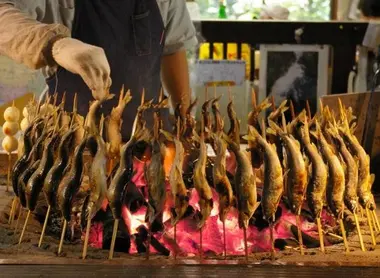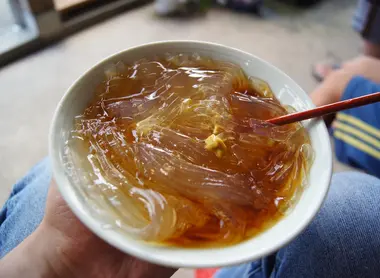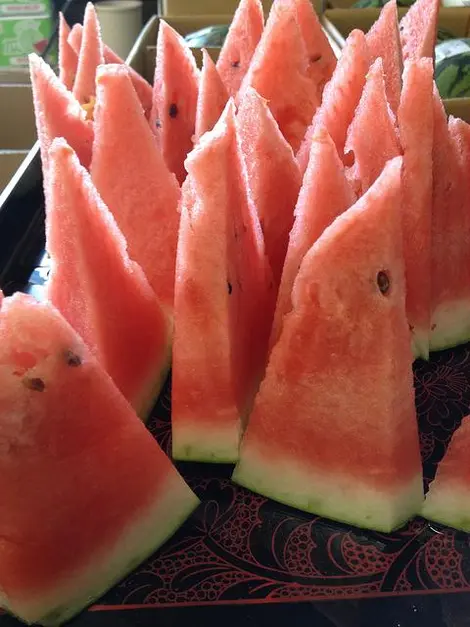Summer Foods 夏の料理
- Published on : 14/08/2020
- by : C.W.
- Youtube
Seasonal Recipes
The Japanese summer is hot. Very hot! Inside, the air conditioning may offer a break, but outside, you might find it hard to find a corner in the shade. Fortunately, some seasonal cuisine can bring a cool touch to your stay.
Discover our selection of refreshing Japanese dishes to enjoy during the summer:
Watermelons
More than just refreshment, watermelons are an integral part of Japanese summer. On Japanese beaches people regularly have suika-wari parties, literally "watermelon-splitting parties" These involve hitting the watermelon with a baseball bat while blindfolded, until it breaks and can be enjoyed by everyone.
But the popularity of the fruit does not stop there. In recent years, producers have modified the shapes of watermelon (squares, hearts, pyramids...) to make them more convenient to carry, or simply more original. But their prices are often much higher than the traditional round shape.
Kakigori
What's better than ice under the blazing sun? With various flavors, kakigori is cups of shaved ice like freshly fallen snow covered in the syrup of your choice. Among the most popular flavors are cherry, blueberry, lemon, green tea, and melon.
A dessert once reserved for the Japanese elite, kakigori has become a popular and inexpensive treat that can now be made at home. In Kyoto, the shop Gion Koishi is famous for its delicious cups of shaved ice.
Cold noodles
A signature dish of the summer, cold noodles, or zaru soba, served alone or with vegetable tempura (fried vegetables) is a fresh, light, and a popular Japanese dish. These buckwheat noodles are soaked in a cold broth made of water, soy sauce, mirin (a sweet cooking sake) and dashi (a fish or seaweed based broth).
Another typical summer dish is somen, which is a very thin white noodles. Eaten with a soy sauce, mixed with condiments (negi, grated ginger, wasabi or sesame) or in salads as in the Kansai region, another specialty of the summer is nagashi-somen. The nagashi-somen are to be grabbed with the chopsticks' tips as they flow past you in a cold water slide made of bamboo.
Hiyashi chuka is also a popular dish of the season: made with cold ramen noodles, topped with omelet, carrots, cucumbers, ham or poultry and served with a tare sauce, with a vinegar flavor.
Ayu
In early June, grilled ayu season starts. These freshwater fish are lightly sweet and have a subtle texture that makes them one of the most popular food at summer festivals.
Traditionally, people barbecue and eat ayu while remembering the fish's tough journey upriver against the current. Like carp, it is a symbol for the Japanese of perseverance and courage.
Umeshu
Every year in June, people begin making umeshu, a Japanese alcohol made from plums, sake and sugar. Fermentation requires almost a year!
Renowned for its invigorating power, umeshu is an effective remedy against the tiredness associated with hot weather! Served with ice or fresh water, this drink is the perfect aperitif to enjoy on the kawayuka in Kyoto, special terraces set up in the early summer along the Kamogawa River.
Hyayakko
Hyayakko is a chilled tofu dish, served with various toppings. The choice of accompaniments varies according to taste, hyayakko can be served with shiso leaves (perilla frutescens), yuzu (Japanese citrus fruit), daikon (Japanese radish), ginger, okra slices, plum or with mustard. Don't forget the soy sauce!
Tokoroten
Tokoroten comes in the form of noodles, produced using agar-agar jelly (seaweed extract). Refreshing, rich in fiber, tokoroten is largely composed of water. The noodles are drizzled with a sweet or savory sauce, the taste depends on the region: vinegar in Kyoto, brown sugar in Osaka, or even chilli, sesame and soy sauce.
Edamame
Accompanied by a cold beer, these green soybeans are also a popular summer treat. Ideal for taking with you on picnics or while watching the fireworks!
Anmitsu
Anmitsu is a dessert made from agar-agar jelly cubes, azuki red bean paste, fruit, and mochi balls, all drizzled with black sugar syrup and kuromitsu. Variants exist, in particular with ice cream, cream anmitsu.
